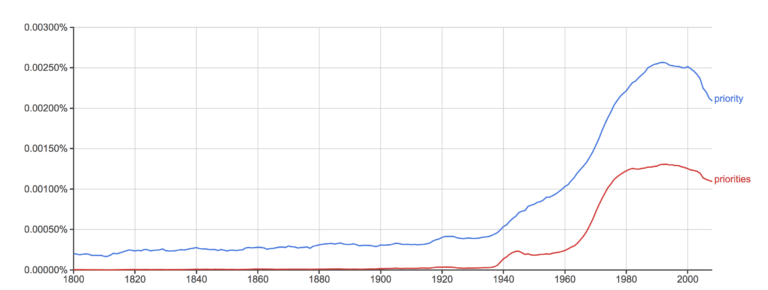
Laser Focus
Lasers are cool. “LASER” stands for “light amplification by stimulated emission of radiation.” Lasers are special because they emit light coherently both spatially and temporally. Spatial coherency means the light can be focus narrowly and that it will remain narrow for long distances. Temporal focus means a laser can emit a single color of light. More on lasers in a bit.
I was playing with Google’s Ngram viewer. Ngram is a fancy term that means: a phrase of N words. For example, trigrams are three word phrases. Google’s Ngram Viewer looks at all the books Google has slurped into their search engines from 1500 to 2008 and gives you the ability to find the frequency of whatever word or phrase you’re looking for.
If you input “priority” and “priorities” you get the following graph:

What is interesting is that the word “priorities” doesn’t even get used until after 1940. The plural doesn’t make sense really. If you have “priorities” how many do you have?
Priority: the single thing that is most important in the things that you do. You can do many things, but the others are not as important as your priority.
Lasers are useful for an amazingly wide range functions. They have been applied in communications, printing, welding, measuring, surgery and even DNA sequencing. The reason lasers are so useful is because they are so focused. However, the resulting light beam is created by a complex array of electronics, chemistry and optics. In other words, it takes a broad range of things to produce a focused beam of light.
As leaders, we often suffer from lack of focus, or too many priorities. We are presented with so many good options for how we can expend our personal and organizational resources that we often get spread too thin. The secret to effective leadership is to narrow our focus while we broaden our influence. Ok, that did sound a little like a quip from a self-help book.
What I mean is, we first must remain absolutely clear, in each and every moment, about what our priority is (singular, not plural). Of course, this requires us to have and acknowledge a priority. This is true for an organization too. At Kimray, our priority is to make a difference in the lives of those we serve. “But that’s our mission,” you say. Right. Exactly. Mission = Priority. What is your personal mission?
We need to broaden our influence because no one accomplishes their mission in life alone. No one. We need other people. We were designed to live and thrive in community. The bigger your community is, the more wisdom and support you can access. Being connected on LinkedIn is not community. Exchanging cards at a meet-and-greet is not community. Relationship, shared experience and common ground is community. Knowing and being known. That’s where influence is, both the influence we have on others and the influences others have on us.
The clearer our priority, the more we get done.
The broader our true connections, the better our vision.
